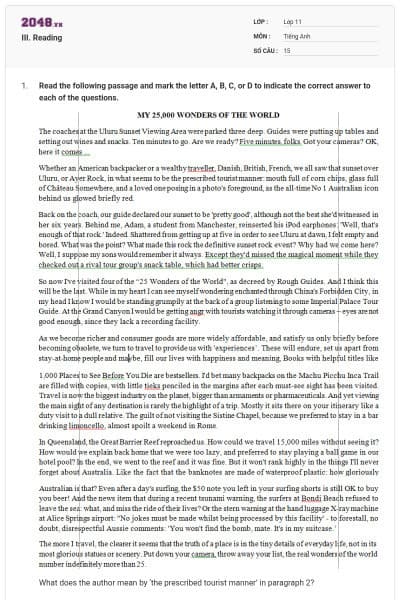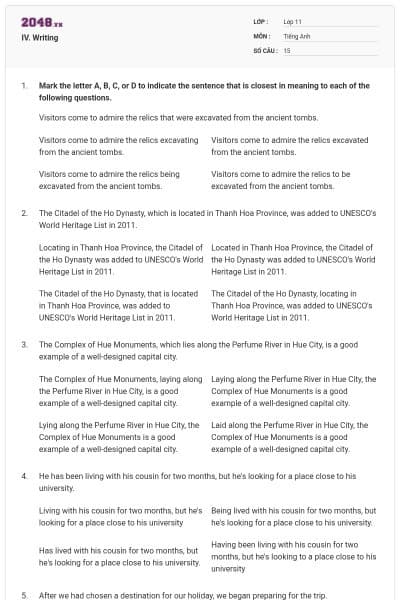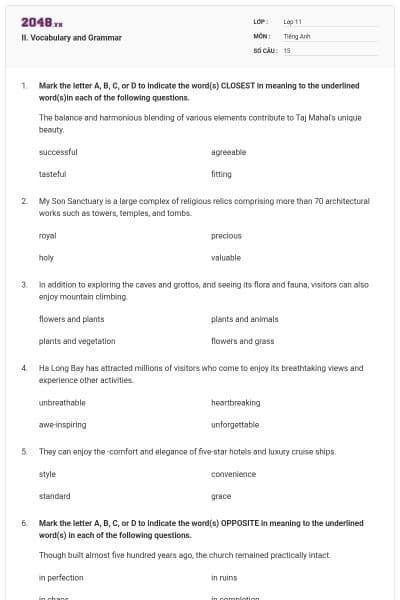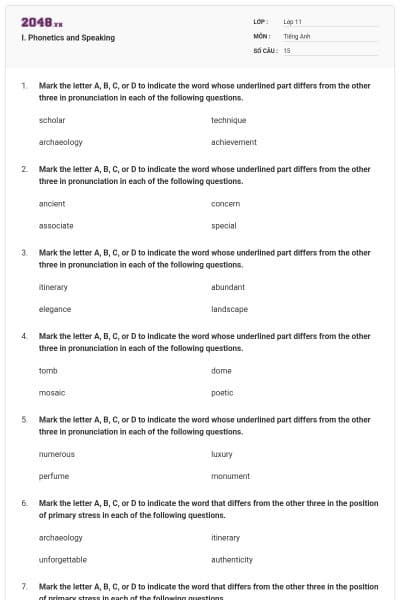15 câu hỏi
Read the following passage and mark the letter A, B, C, or D to indicate the correct answer to each of the questions.
What does the author mean by ‘the prescribed tourist manner’ in paragraph 2?
They are all backpackers.
They are all wealthy travellers.
They are all interested in seeing the wonders of the world
They all eat, drink and do the same things at the sites of the world wonders.
Read the following passage and mark the letter A, B, C, or D to indicate the correct answer to each of the questions.
What did the author think or feel after seeing the sunset over Ayer Rock?
She thought it was pretty good.
She felt exhausted, empty, and bored.
She thought that was enough.
She thought this rock was the definitive sunset rock event.
Read the following passage and mark the letter A, B, C, or D to indicate the correct answer to each of the questions.
Why does she think that Uluru is probably the last 'wonder of the world' she will see?
She doesn't like wandering around the wonders.
She doesn't enjoy the Imperial Palace Tour Guide.
She doesn't like watching the wonder through a camera.
She doesn't want to explore the sites the way people around her do.
Read the following passage and mark the letter A, B, C, or D to indicate the correct answer to each of the questions.
What kind of tourists is she criticising when she says 'eyes are not good enough' in paragraph 4?
those who stand grumpily at the back of the group
those who wander enchanted through the site
those who look at the wonders through their cameras
those who lack a recording facility
Read the following passage and mark the letter A, B, C, or D to indicate the correct answer to each of the questions.
According to the author, what do a lot of backpackers carry with them nowadays?
books with helpful titles
books that are bestsellers
copies of must-see sights
little pencils
Read the following passage and mark the letter A, B, C, or D to indicate the correct answer to each of the questions.
The author compares visiting the main tourist sights to ____.
armaments
Pharmaceuticals
a trip highlight
a duty visit to a dull relative
Read the following passage and mark the letter A, B, C, or D to indicate the correct answer to each of the questions.
What does she mean by ‘the Great Barrier Reef reproached us' in paragraph 6?
The Great Barrier Reef is worth visiting if you are in Australia.
It is fine to visit the Great Barrier Reef when you are in Australia.
It seems wrong not to visit the Great Barrier Reef once you are in Australia.
The Great Barrier Reef is an unforgettable sight in Australia.
Read the following passage and mark the letter A, B, C, or D to indicate the correct answer to each of the questions.
All of the following are mentioned in the article as memorable aspects of Australia EXCEPT ____.
banknotes made of waterproof plastic
the fine visit to the Great Barrier Reef
the surfers at Bondi Beach refusing to leave the sea despite tsunami warning
the stern warning at the hand luggage X-ray machine at Alice Springs airport.
Read the following passage and mark the letter A, B, C, or D on your answer sheet to indicate the correct answer to each of the questions.
Herman Melville, an American author best known today for his novel Moby Dick, was actually more popular during his lifetime for some of his other works. He traveled extensively and used the knowledge gained during his travels as the basis for his early novels. In 1837, at the age of eighteen, Melville signed as a cabin boy on a merchant ship that was to sail from his Massachusetts home to Liverpool, England. His experiences on this trip served as a basis for the novel Redburn (1849). In 1841 Melville set out on a whaling ship headed for the South Seas. After jumping ship in Tahiti, he wandered around the islands of Tahiti and Moorea. This South Sea island sojourn was a backdrop to the novel Omoo (1847). After three years away from home, Melville joined up with a U.S. naval frigate that was returning to the eastern United States around Cape Horn. The novel White-Jacket (1850) describes this lengthy voyage as a navy seaman. With the publication of these early adventure novels, Melville developed a strong and loyal following among readers eager for his tales of exotic places and situations. However, in 1851, with the publication of Moby Dick, Melville's popularity started to diminish. Moby Dick, on one level the saga of the hunt for the great white whale, was also a heavily symbolic allegory of the heroic struggle of man against the universe. The public was not ready for Melville's literary metamorphosis from romantic adventure to philosophical symbolism. It is ironic that the novel that served to diminish Melville's popularity during his lifetime is the one for which he is best known today.
The main subject of the passage is_________.
Melville’s travels
Moby Dick
Melville’s personal background
the popularity of Melville’s novels.
Read the following passage and mark the letter A, B, C, or D on your answer sheet to indicate the correct answer to each of the questions.
Herman Melville, an American author best known today for his novel Moby Dick, was actually more popular during his lifetime for some of his other works. He traveled extensively and used the knowledge gained during his travels as the basis for his early novels. In 1837, at the age of eighteen, Melville signed as a cabin boy on a merchant ship that was to sail from his Massachusetts home to Liverpool, England. His experiences on this trip served as a basis for the novel Redburn (1849). In 1841 Melville set out on a whaling ship headed for the South Seas. After jumping ship in Tahiti, he wandered around the islands of Tahiti and Moorea. This South Sea island sojourn was a backdrop to the novel Omoo (1847). After three years away from home, Melville joined up with a U.S. naval frigate that was returning to the eastern United States around Cape Horn. The novel White-Jacket (1850) describes this lengthy voyage as a navy seaman. With the publication of these early adventure novels, Melville developed a strong and loyal following among readers eager for his tales of exotic places and situations. However, in 1851, with the publication of Moby Dick, Melville's popularity started to diminish. Moby Dick, on one level the saga of the hunt for the great white whale, was also a heavily symbolic allegory of the heroic struggle of man against the universe. The public was not ready for Melville's literary metamorphosis from romantic adventure to philosophical symbolism. It is ironic that the novel that served to diminish Melville's popularity during his lifetime is the one for which he is best known today.
The word “basis” in paragraph 1 is closest in meaning to_________.
background
message
bottom
dissertation
Read the following passage and mark the letter A, B, C, or D on your answer sheet to indicate the correct answer to each of the questions.
Herman Melville, an American author best known today for his novel Moby Dick, was actually more popular during his lifetime for some of his other works. He traveled extensively and used the knowledge gained during his travels as the basis for his early novels. In 1837, at the age of eighteen, Melville signed as a cabin boy on a merchant ship that was to sail from his Massachusetts home to Liverpool, England. His experiences on this trip served as a basis for the novel Redburn (1849). In 1841 Melville set out on a whaling ship headed for the South Seas. After jumping ship in Tahiti, he wandered around the islands of Tahiti and Moorea. This South Sea island sojourn was a backdrop to the novel Omoo (1847). After three years away from home, Melville joined up with a U.S. naval frigate that was returning to the eastern United States around Cape Horn. The novel White-Jacket (1850) describes this lengthy voyage as a navy seaman. With the publication of these early adventure novels, Melville developed a strong and loyal following among readers eager for his tales of exotic places and situations. However, in 1851, with the publication of Moby Dick, Melville's popularity started to diminish. Moby Dick, on one level the saga of the hunt for the great white whale, was also a heavily symbolic allegory of the heroic struggle of man against the universe. The public was not ready for Melville's literary metamorphosis from romantic adventure to philosophical symbolism. It is ironic that the novel that served to diminish Melville's popularity during his lifetime is the one for which he is best known today.
According to the passage, Melville’s early novels were__________.
published while he was traveling
completely fictional
all about his work on whaling ships
based on his travel experienc
Read the following passage and mark the letter A, B, C, or D on your answer sheet to indicate the correct answer to each of the questions.
Herman Melville, an American author best known today for his novel Moby Dick, was actually more popular during his lifetime for some of his other works. He traveled extensively and used the knowledge gained during his travels as the basis for his early novels. In 1837, at the age of eighteen, Melville signed as a cabin boy on a merchant ship that was to sail from his Massachusetts home to Liverpool, England. His experiences on this trip served as a basis for the novel Redburn (1849). In 1841 Melville set out on a whaling ship headed for the South Seas. After jumping ship in Tahiti, he wandered around the islands of Tahiti and Moorea. This South Sea island sojourn was a backdrop to the novel Omoo (1847). After three years away from home, Melville joined up with a U.S. naval frigate that was returning to the eastern United States around Cape Horn. The novel White-Jacket (1850) describes this lengthy voyage as a navy seaman. With the publication of these early adventure novels, Melville developed a strong and loyal following among readers eager for his tales of exotic places and situations. However, in 1851, with the publication of Moby Dick, Melville's popularity started to diminish. Moby Dick, on one level the saga of the hunt for the great white whale, was also a heavily symbolic allegory of the heroic struggle of man against the universe. The public was not ready for Melville's literary metamorphosis from romantic adventure to philosophical symbolism. It is ironic that the novel that served to diminish Melville's popularity during his lifetime is the one for which he is best known today.
The passage implies that Melville stayed in Tahiti because____________.
he had unofficially left his ship
he was on leave while his ship was in port
he had finished his term of duty
he had received permission to take a vacation in Tahiti
Read the following passage and mark the letter A, B, C, or D on your answer sheet to indicate the correct answer to each of the questions.
Herman Melville, an American author best known today for his novel Moby Dick, was actually more popular during his lifetime for some of his other works. He traveled extensively and used the knowledge gained during his travels as the basis for his early novels. In 1837, at the age of eighteen, Melville signed as a cabin boy on a merchant ship that was to sail from his Massachusetts home to Liverpool, England. His experiences on this trip served as a basis for the novel Redburn (1849). In 1841 Melville set out on a whaling ship headed for the South Seas. After jumping ship in Tahiti, he wandered around the islands of Tahiti and Moorea. This South Sea island sojourn was a backdrop to the novel Omoo (1847). After three years away from home, Melville joined up with a U.S. naval frigate that was returning to the eastern United States around Cape Horn. The novel White-Jacket (1850) describes this lengthy voyage as a navy seaman. With the publication of these early adventure novels, Melville developed a strong and loyal following among readers eager for his tales of exotic places and situations. However, in 1851, with the publication of Moby Dick, Melville's popularity started to diminish. Moby Dick, on one level the saga of the hunt for the great white whale, was also a heavily symbolic allegory of the heroic struggle of man against the universe. The public was not ready for Melville's literary metamorphosis from romantic adventure to philosophical symbolism. It is ironic that the novel that served to diminish Melville's popularity during his lifetime is the one for which he is best known today.
How did the publication of Moby Dick affect Melville’s popularity?
His popularity remained as strong as ever.
It caused his popularity to decrease.
His popularity increased immediately.
It had no effect on his popularity.
Read the following passage and mark the letter A, B, C, or D on your answer sheet to indicate the correct answer to each of the questions.
Herman Melville, an American author best known today for his novel Moby Dick, was actually more popular during his lifetime for some of his other works. He traveled extensively and used the knowledge gained during his travels as the basis for his early novels. In 1837, at the age of eighteen, Melville signed as a cabin boy on a merchant ship that was to sail from his Massachusetts home to Liverpool, England. His experiences on this trip served as a basis for the novel Redburn (1849). In 1841 Melville set out on a whaling ship headed for the South Seas. After jumping ship in Tahiti, he wandered around the islands of Tahiti and Moorea. This South Sea island sojourn was a backdrop to the novel Omoo (1847). After three years away from home, Melville joined up with a U.S. naval frigate that was returning to the eastern United States around Cape Horn. The novel White-Jacket (1850) describes this lengthy voyage as a navy seaman. With the publication of these early adventure novels, Melville developed a strong and loyal following among readers eager for his tales of exotic places and situations. However, in 1851, with the publication of Moby Dick, Melville's popularity started to diminish. Moby Dick, on one level the saga of the hunt for the great white whale, was also a heavily symbolic allegory of the heroic struggle of man against the universe. The public was not ready for Melville's literary metamorphosis from romantic adventure to philosophical symbolism. It is ironic that the novel that served to diminish Melville's popularity during his lifetime is the one for which he is best known today.
According to the passage, Moby Dick is__________.
symbolic of humanity fighting the universe
a single-faceted work
a short story about a whale
a 47 adventure
Read the following passage and mark the letter A, B, C, or D on your answer sheet to indicate the correct answer to each of the questions.
Herman Melville, an American author best known today for his novel Moby Dick, was actually more popular during his lifetime for some of his other works. He traveled extensively and used the knowledge gained during his travels as the basis for his early novels. In 1837, at the age of eighteen, Melville signed as a cabin boy on a merchant ship that was to sail from his Massachusetts home to Liverpool, England. His experiences on this trip served as a basis for the novel Redburn (1849). In 1841 Melville set out on a whaling ship headed for the South Seas. After jumping ship in Tahiti, he wandered around the islands of Tahiti and Moorea. This South Sea island sojourn was a backdrop to the novel Omoo (1847). After three years away from home, Melville joined up with a U.S. naval frigate that was returning to the eastern United States around Cape Horn. The novel White-Jacket (1850) describes this lengthy voyage as a navy seaman. With the publication of these early adventure novels, Melville developed a strong and loyal following among readers eager for his tales of exotic places and situations. However, in 1851, with the publication of Moby Dick, Melville's popularity started to diminish. Moby Dick, on one level the saga of the hunt for the great white whale, was also a heavily symbolic allegory of the heroic struggle of man against the universe. The public was not ready for Melville's literary metamorphosis from romantic adventure to philosophical symbolism. It is ironic that the novel that served to diminish Melville's popularity during his lifetime is the one for which he is best known today.
In what year did Melville’s book about his experiences as a cabin boy appear?
1849
1837
1847
1841








